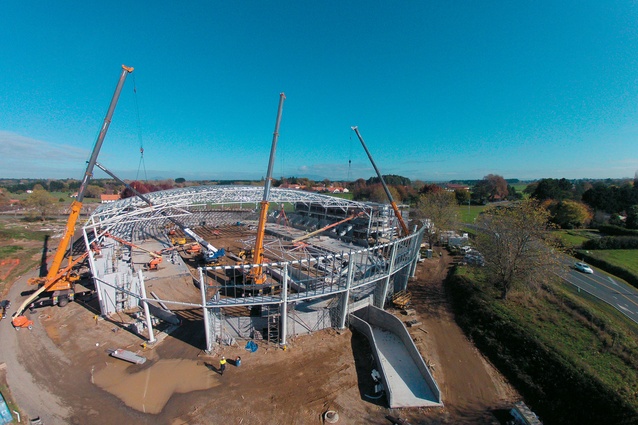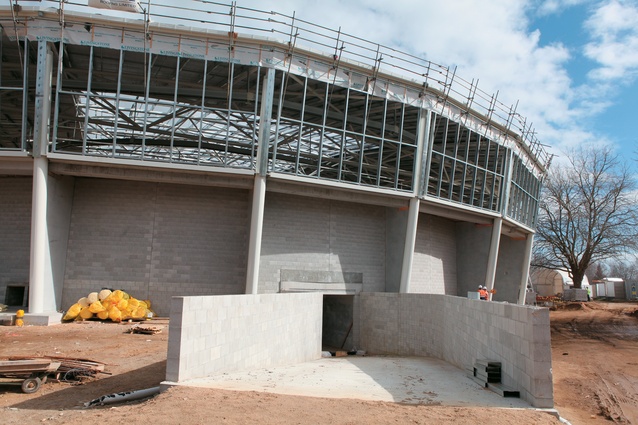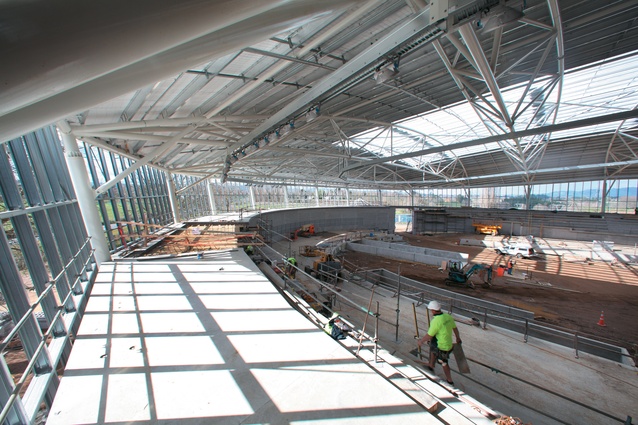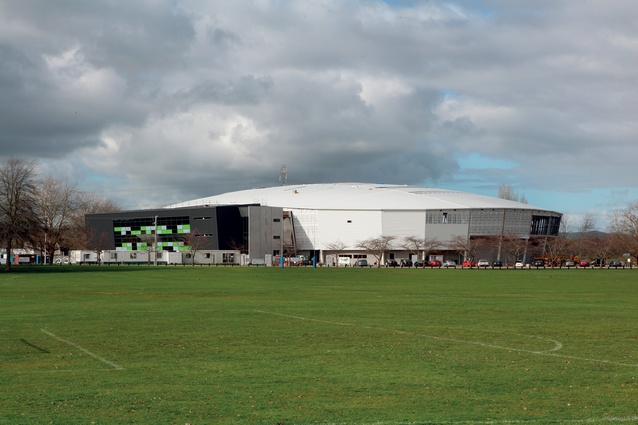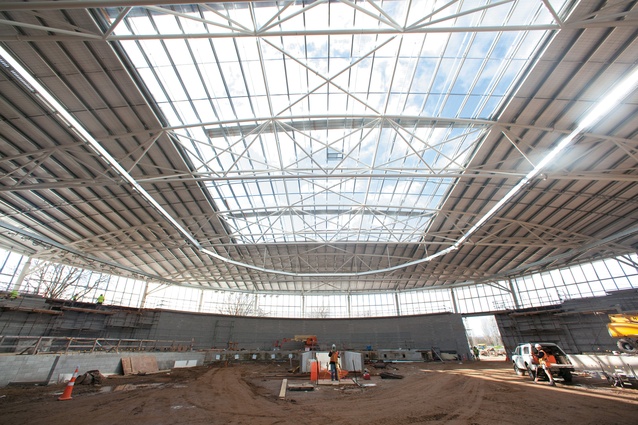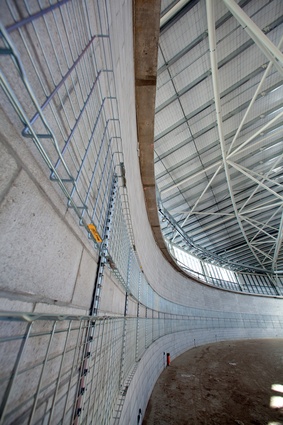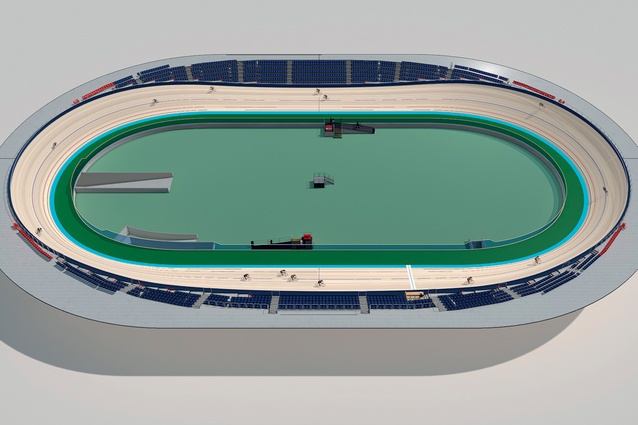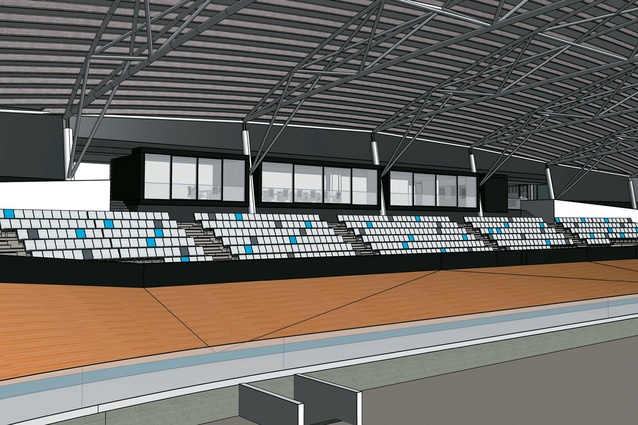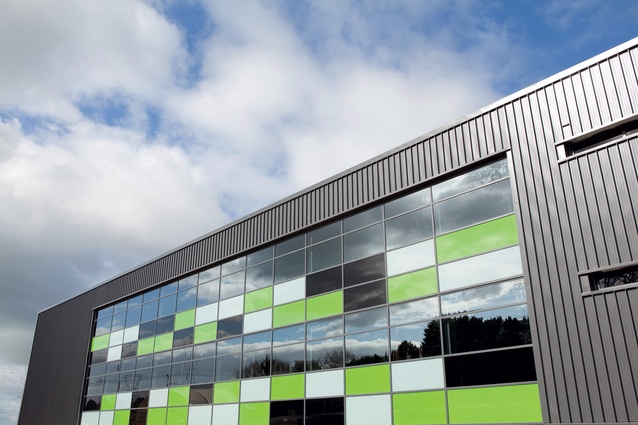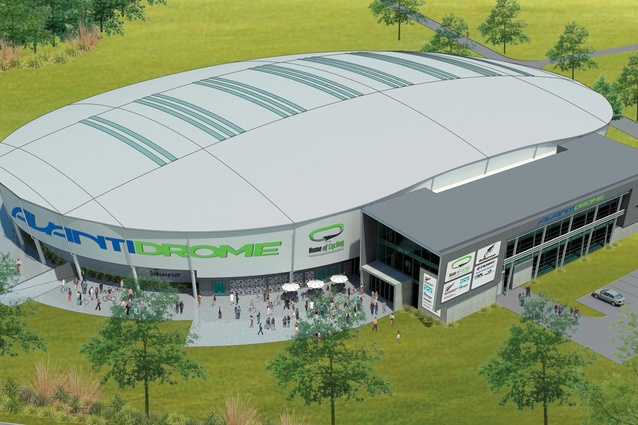On track
A world-class cycling facility is taking shape near Cambridge. We talked to Livingstone Builders about this complex build.
Cycling is about to have a new home in New Zealand, with construction of a state-of-the-art velodrome on track for completion in early 2014. The $28.5 million, 10,000m 2 facility sits on a tight site sandwiched between a steep gully and SH1 near Cambridge. Named the Home of Cycling Avantidrome, it incorporates a 250-metre world-class track, a clear span roof, three tunnels into the infield, 1,500 permanent seats, and the capacity to introduce 2,500 more for hosting world championships and other events.
The adjoining administration building will house a gym, corporate offices, storage, medical centre, treatment and consultation rooms, recovery room (hot and cold plunge pools)spa and sauna facilities, a cafe and a retail space. Dominic Buckell of Chibnall Buckell Marovic Team Architects said a decision was made early on to structurally separate the arena from the office and administration part of the facility.
“This led to the arena envelope being designed to efficiently enclose the track and associated spectator seating and concourse, but still have its shape related to, and expressive of, the indoor track with curved ends and banked surfaces,” Mr Buckell said. “The roof geometry of the arena is a form of toroid (doughnut-shaped). The roof trusses are rotated around a centre point and then the resulting roof plane trimmed to suit the plan shape required. For budget reasons the wall claddings were faceted rather than curved, but nevertheless an expressive arena enclosure was created. The base of the arena columns were kept exposed on the exterior to maintain the structurally expressive language of the building and help to reduce the visual mass of the arena.”
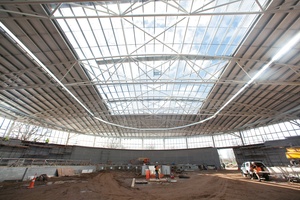
The complex design of the arena means the building structure is not symmetrical and the track itself is not symmetrical either. The geometry of seating for sight lines is designed to work in accordingly. Over 6,000 co-ordinate points were used to establish the precise position of inner and outer walls between which the timber track will be installed.
Livingstone Builders project manager Neville Davy said the track was designed and made in Germany by Ralph Schürmann of Schürmann Architects. The designer and a team of 13 staff will travel to New Zealand and install the track in seven weeks with the help of a further 13 New Zealand contractors. “There is a 43 degree degree pitch on the corners of the track. It is made of Siberian Spruce and will be built on a 300x75mm timber joist,” Mr Davy said.
The roof area is not a true oval, so it was coordinated in 500mm intervals. “That in itself has been very challenging. The roof area is 9,000m 2 . The mass of reinforcing and structural steel in the roof trusses came from parts of Asia and Taiwan but the steel itself was fabricated in Auckland, Hamilton and Tauranga by Jensen Steel and then assembled on site. The nine trusses were each in three pieces and arrived in 27 truckloads from Auckland; each truss was about one day’s work to erect.”
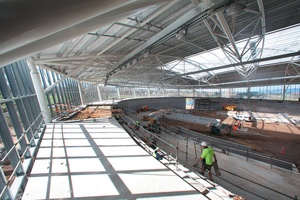
The clear span roof was a requirement of the client, to create clear sight lines around the entire arena, and meet International Cycling Union (UCI) standards. From the ground, it is 19 metres to the apex of the roof, to the top of the truss, which is 77 metres wide, and 120 metres long. More than 650 tonnes of steel was used in the arena alone. The nature of the structure itself required extensive work to go into the foundations.
“We had to drill 1200mm diameter holes, on average eight metres deep. A two-metre pile cap was then installed on top of the concrete foundations. About 770m 3 of concrete was poured around the columns for the arena. That’s a fair chunk of concrete to be putting in the ground.” The track itself has a flat ‘safety zone’ around the interior of the infield; it is six metres from this point to the top of the track. With approximately 60 contractors on site each day, 38,000 concrete blocks were used, 109 pre-cast concrete bleachers, 78 tilt panels, and 3,800 cubic metres of concrete in the entire building.
“There’s an enormous amount of wind pressure on this building so we are using a mass of concrete to hold it in place. It is designed to move in the wind by 60mm either way, and we expect it will move about 10mm’s over a year on average.”
Designing a facility that meets the needs of the athletes, the community, and global UCI specifications meant the design needed to incorporate various changes and elements that at the start did not seem the obvious option. “We had to consult with the athletes about what they needed during the design phase. One of the things they mentioned was the need for toilets in the athletes’ tunnel leading to the infield (due to the need for sight lines three tunnels lead from different parts of the facility and exterior underneath the track into the infield).”
Mr Buckell said although it was preferable to have day lighting in the arena, the athletes preferred this was not achieved by using windows around the concourse due to the resulting distracting shadows and/or bright spots in their line of sight. As a result, it was decided regularly placed skylights would be placed along the central section of the roof. There are two rails of track lighting in the arena totalling 356 lights, which can provide up to a maximum 2,000 lux for the purposes of televising events.
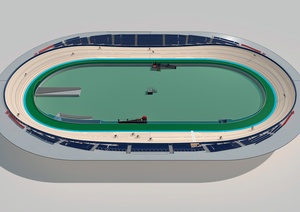
There is a five-degree pitch to the exterior of the building, which provided its own challenges. A full facade system is being completed by APL, using 135mm Flush Glaze double glazed glass with a silver/grey low E coating. A new Coloursteel ‘Bounce’ prefinished steel product will be used on the arena roof and wall claddings. The arena will be heated year-round with under floor heating, to an ambient temperature of 17 degrees. The whole building is insulated, and due to acoustics, insulation will also be installed in the roof to reduce rain noise.
Home of Cycling Charitable Trust chief executive Geoff Balme said the facility would become a national centre of excellence for cycling, and unofficially centralise the sport in New Zealand. “The government was looking to make a further investment into high performance sporting facilities in New Zealand, and it was identified cycling would be the focus of that investment,” Mr Balme said. “The world-class track meets UCI Category 1 standards, and will be capable of holding major events. ”
The track is the second indoor velodrome in New Zealand (the other is in Invercargill) and as such, will host the national championships every two years, the Oceania Championships every four years and world cup and world championship events, and the Oceania Championships every four years. “Apart from cycling events, we already have interest in using the facility for a range of things, including a wedding. The athletes will only use the facility for 25 per cent of the time, so it will be operating for a further 70 hours a week when it will be available for public and community use.”
Livingstone Builders director Mike Livingstone said despite a host of design changes and changes to what is inside the building, the project team was still working to the budget that has been in place since February 2011, well before construction started. “This is a landmark project. It’s going to do a lot for the community and we are excited to have been a part of it.”

